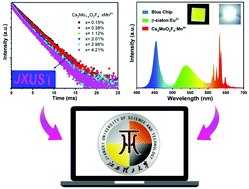A novel Mn4+ doped oxyfluoride red phosphor for rapid-response backlights display†
Abstract
An oxyfluoride red phosphor Cs2MoO2F4:Mn4+ was synthesized via a facile co-precipitation route with a certain molecular ratio of CsF and MoO3. X-ray diffraction analysis and its Rietveld refinement reveal that Cs2MoO2F4:Mn4+ crystallized in an orthorhombic structure with the Amam (63) space group. Upon blue light excitation, Cs2MoO2F4:Mn4+ exhibits a series of sharp red emission lines around ∼634 nm and the zero-phonon line (ZPL) is visible at 619 nm. The optimal doping amount of Mn4+ in Cs2MoO2F4 is 1.12%, and the decay curves show a good fit with the single exponential decay model. The fluorescence lifetime of the synthesized phosphors is relatively short and calculated as 3.18 to 2.46 ms, the Mn4+ ions in Cs2MoO2F4 experience a strong crystal field strength with a Dq/B of ∼4.87, and the distinct nephelauxetic ratio β1 is determined to be ∼1.0226. The thermal quenching mechanism of Mn4+ was also studied. Furthermore, by using the as-synthesized Cs2MoO2F4:Mn4+ phosphor as a red component and β-SiALON as a green light component, a WLED was fabricated with a high luminous efficacy of 114.70 lm·W−1 and wide color gamut of 109.1% of the National Television Standard Committee (NTSC) value. Hence, the Cs2MoO2F4:Mn4+ phosphor with a short fluorescence lifetime could potentially be an efficient red compensator for application in rapid-response backlight displays.



 Please wait while we load your content...
Please wait while we load your content...